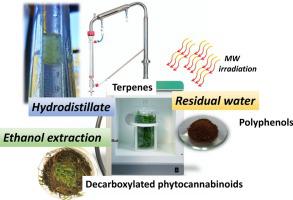Industrial Crops and Products ( IF 5.6 ) Pub Date : 2021-02-04 , DOI: 10.1016/j.indcrop.2021.113247 Veronika Gunjević , Giorgio Grillo , Diego Carnaroglio , Arianna Binello , Alessandro Barge , Giancarlo Cravotto

|
In recent years, hemps health and nutritional properties recognition has led to an impressive growth of Cannabis research, industrial processing, and the related market. Moreover, the demand for natural Cannabis-derived compounds (i.e. terpenes, polyphenols, and cannabinoids) is constantly growing. In spite of the strict regulation of some countries, the global market needs suitable technologies for the smart recovery of bioactive Cannabis metabolites. Conventional extraction procedures can show drawbacks, in terms of environmental impact and their high energy consumption. Microwaves (MW), a mature technique for extraction-process intensification, is attracting great amounts of attention in academic-research and industrial-application fields for its technological advantages. This work aims to design a fast and cost-efficient MW-assisted cascade protocol for bioactive Cannabis compounds recovery in a pilot-scale reactor. Microwave-assisted hydrodistillation (MAHD) can provide a volatile hydrodistillate that is rich in monoterpenes, sesquiterpenes, and a small amount of phytocannabinoids. Using non-canonical protocol of hydrodistillation, the definition of “volatile fraction” is generally considered more appropriate than “essential oil”.
The health-promoting activity of this combination has been proposed in literature, and can constitute matter of further investigations. The optimized MAHD procedure yielded 0.35 ± 0.02 % w/w of hydrodistillate, while conventional hydrodistillation gave only 0.12 ± 0.01 %, w/w (in relation to dry inflorescence mass). The water resulting in the vessel after MAHD showed a high total polyphenolic content (5.35 ± 0.23 %, w/w). Two flavones known for their beneficial effects to health, namely luteolin-7-O-glucoside and apigenin-7-O-glucoside, were detected and quantified. An attempt to recover phytocannabinoid using the MW-assisted hydrodiffusion and gravity method (MAHG) was also carried out. Cannabinoids (CBD and THC) content was determined in fresh Cannabis and in production streams. During MAHD, phytocannabinoid decarboxylation inside the residual matrix was around 70 % (69.01 ± 0.98 % and 74.32 ± 1.02 % for THC and CBD respectively). Furthermore, the overall content of these metabolites was not affected by the hydrodistillation, preserving the processed plant material for subsequent ethanolic extraction.
中文翻译:

微波从大麻花序中选择性回收萜烯,多酚和大麻素
近年来,对大麻健康和营养特性的认可导致大麻研究,工业加工和相关市场的显着增长。此外,对天然大麻衍生化合物(即萜烯,多酚和大麻素)的需求不断增长。尽管某些国家进行了严格的监管,但全球市场仍需要合适的技术来智能回收生物活性大麻代谢产物。就环境影响及其高能耗而言,常规提取程序可能会显示出缺点。微波(MW)是一种用于萃取过程强化的成熟技术,由于其技术优势而在学术研究和工业应用领域引起了广泛的关注。这项工作旨在设计一种中试规模的反应器中生物活性大麻化合物回收的快速且经济高效的兆瓦级联协议。微波辅助加氢蒸馏(MAHD)可以提供富含单萜,倍半萜烯和少量植物大麻素的挥发性加氢蒸馏物。使用加氢蒸馏的非规范协议,通常认为“挥发分”的定义比“精油”更合适。
该组合的健康促进活性已经在文献中提出,并且可以构成进一步研究的问题。优化的MAHD程序可产生0.35±0.02%w / w的加氢蒸馏物,而常规加氢蒸馏仅可得到0.12±0.01%w / w(相对于干花序质量)。MAHD后在容器中产生的水显示出高的总多酚含量(5.35±0.23%,w / w)。检测并定量了两种对健康有益的黄酮,即木犀草素-7- O-葡糖苷和芹菜素-7- O-葡糖苷。还尝试了使用MW辅助的水扩散和重力法(MAHG)回收植物大麻素。测定新鲜大麻中的大麻素(CBD和THC)含量并在生产流中。在MAHD期间,残留基质内部的植物大麻素脱羧约为70%(THC和CBD分别为69.01±0.98%和74.32±1.02%)。此外,这些代谢产物的总含量不受加氢蒸馏的影响,从而保留了加工后的植物材料,以便随后进行乙醇提取。











































 京公网安备 11010802027423号
京公网安备 11010802027423号